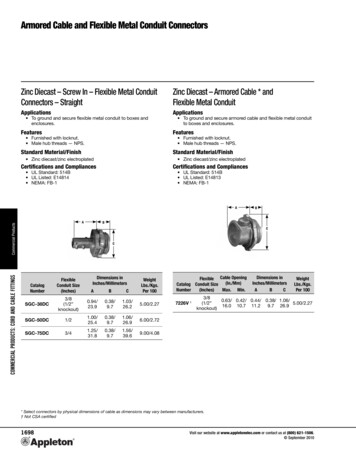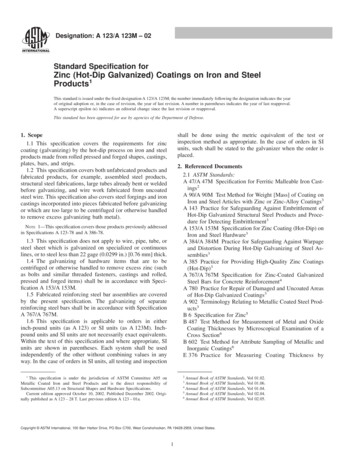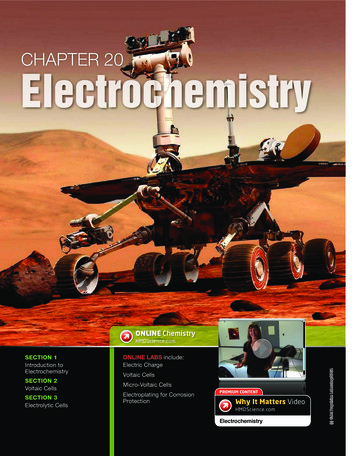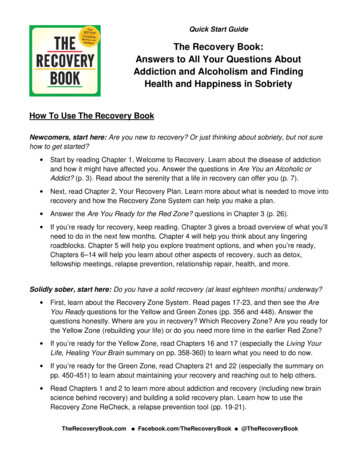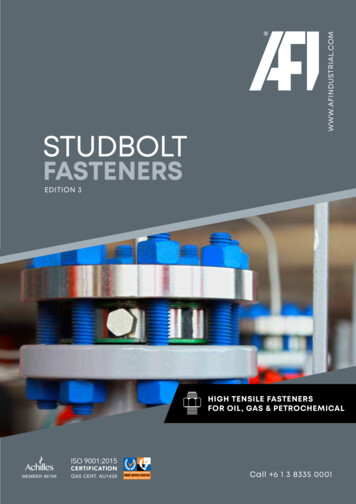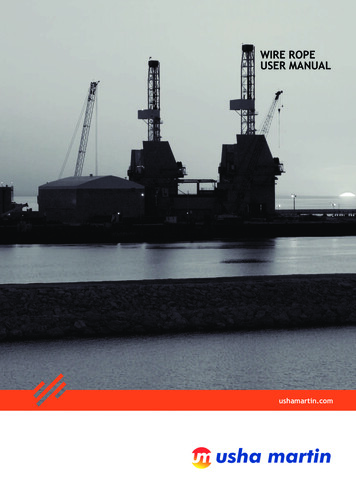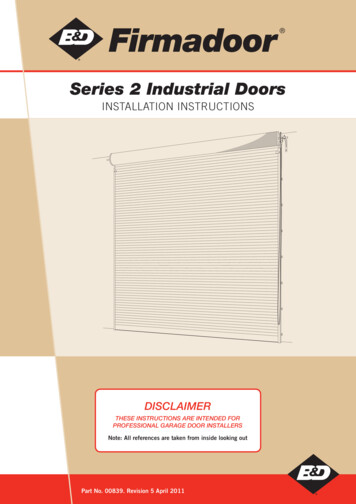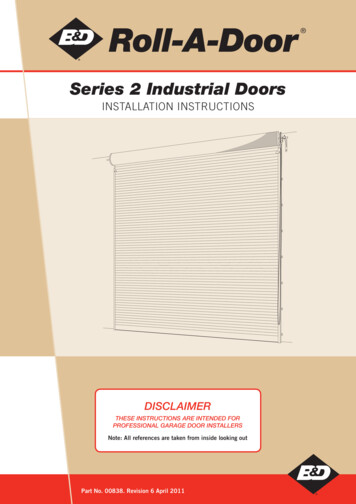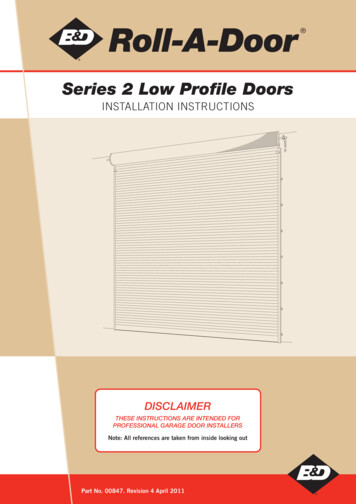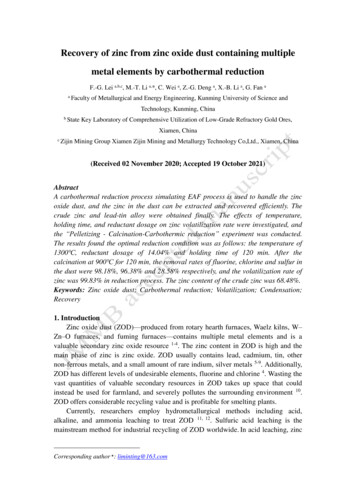
Transcription
Recovery of zinc from zinc oxide dust containing multiplemetal elements by carbothermal reductionF.-G. Lei a,b,c, M.-T. Li a,*, C. Wei a, Z.-G. Deng a, X.-B. Li a, G. Fan aaFaculty of Metallurgical and Energy Engineering, Kunming University of Science andTechnology, Kunming, Chinab StateKey Laboratory of Comprehensive Utilization of Low-Grade Refractory Gold Ores,Xiamen, ChinacZijin Mining Group Xiamen Zijin Mining and Metallurgy Technology Co,Ltd., Xiamen, China(Received 02 November 2020; Accepted 19 October 2021)AbstractA carbothermal reduction process simulating EAF process is used to handle the zincoxide dust, and the zinc in the dust can be extracted and recovered efficiently. Thecrude zinc and lead-tin alloy were obtained finally. The effects of temperature,holding time, and reductant dosage on zinc volatilization rate were investigated, andthe “Pelletizing - Calcination-Carbothermic reduction” experiment was conducted.The results found the optimal reduction condition was as follows: the temperature of1300 , reductant dosage of 14.04% and holding time of 120 min. After thecalcination at 900 for 120 min, the removal rates of fluorine, chlorine and sulfur inthe dust were 98.18%, 96.38% and 28.58% respectively, and the volatilization rate ofzinc was 99.83% in reduction process. The zinc content of the crude zinc was 68.48%.Keywords: Zinc oxide dust; Carbothermal reduction; Volatilization; Condensation;Recovery1. IntroductionZinc oxide dust (ZOD)—produced from rotary hearth furnaces, Waelz kilns, W–Zn–O furnaces, and fuming furnaces—contains multiple metal elements and is avaluable secondary zinc oxide resource 1-4. The zinc content in ZOD is high and themain phase of zinc is zinc oxide. ZOD usually contains lead, cadmium, tin, othernon-ferrous metals, and a small amount of rare indium, silver metals 5-9. Additionally,ZOD has different levels of undesirable elements, fluorine and chlorine 4. Wasting thevast quantities of valuable secondary resources in ZOD takes up space that couldinstead be used for farmland, and severely pollutes the surrounding environment 10.ZOD offers considerable recycling value and is profitable for smelting plants.Currently, researchers employ hydrometallurgical methods including acid,alkaline, and ammonia leaching to treat ZOD 11, 12. Sulfuric acid leaching is themainstream method for industrial recycling of ZOD worldwide. In acid leaching, zincCorresponding author *: liminting@163.com
in ZOD is leached with sulfuric acid (H2SO4) and recovered from the pregnant leachsolution via electrowinning, and lead enters the leach residue as sulphate 13-16.Sulfuric acid leaching is suitable for ZOD containing relatively lowconcentrations of lead. However, at high lead concentrations, substantial quantities ofthe lead convert to lead sulfate, which could form a loose structure. As a result, thezinc oxide or zinc ferrite may be encapsulated 16-18. This may result in a poor zincleaching rate 16. Increasing the liquid/solid ratio can counteract the encapsulationeffect to some extent through magnifying the mass transfer and diffusion 19-21.However, excessively increasing the liquid/solid ratio changes the pH, resulting ingeneration of a silica gel. This is disadvantageous to solid-liquid separation.Furthermore, the Zn2 concentration in the leach solution, generally 170–200 g/Lduring electrowinning, decreases to an extent that hinders electrowinning 22.Additionally, the substantial amount of leach residue is produced in the leaching stagebecause of the high content lead in ZOD 13, 23, 24. The leach residue includes highconcentration of heavy metals such as lead, zinc, nickel, cadmium, manganese,arsenic 24-27. Since the leach residue is classified as a hazardous waste 13, 28, it’s neededto be disposed through, such as, the Outotec Ausmelt technology, the Waelz Kilnprocess 29. For the whole process, sulfuric acid leaching and dispose of the leachresidue, circulation of sulfur, i.e., sulfuric acid leach residue sulfuric acid, whichincreases the cost. Consequently, lead and zinc are recovered asynchronous in sulfuricacid leaching, which increases the cost. Besides, in hydrometallurgical method, thelarge consumption of leaching agent and disposal of a large amount of wastewateralso increase cost 26, and the simultaneous separation and recovery of valuableelements and the recovery of tin are difficult to achieve.The generation of arsine is also a health and safety issue that cannot be ignored.Fluorine and chlorine in ZOD would bring strongly detriments to electrowinning,such as aluminum cathode and anode grid corrosion 4, 30. Thus, Fluorine and chlorinehave to be removed in an additional step. In general, the concentrations of fluorineand chlorine ion in electrolytes must meet electrolysis requirements (F 80mg/L, Cl 100 mg/L) in the electrowinning 4.The ZOD produced from blast furnace slag treated by a rotary hearth furnace isfrom a secondary resource processing plant in Yunnan province, and the yield of theZOD is about 600 t annually. The lead, fluorine and chlorine content in the ZOD arehigh. Therefore, the ZOD is not readily amenable to traditional hydrometallurgicalmethod, and synchronous recycling of zinc, lead and tin in the ZOD is hard to achievewith it. Pyrometallurgical processes such as blast furnace and electric arc furnace(EAF) methods can be used to dispose ZOD. However, the blast furnace is suitablefor treating large-scale material, which has no advantage for disposing the ZOD ineconomy. In addition, if the ZOD is used as a charge mixture in blast furnace process,tin in the ZOD is difficult to be recovered due to dilution of tin. The treatment scale ofEAF is flexible, and it can achieve synchronous recycling of zinc, lead and tin in theZOD. At present, the EAF method is often used to treat zinc calcine with a leadcontent of not more than 5%. The research object in this paper is a zinc oxide dustwith a lead content of 27.65%. This work is a laboratory-scale attempt to treat zinc
oxide dust with high lead content by EAF method.A carbothermal reduction process simulating EAF process is used to handle theZOD in this work. In the process, zinc oxide can turn into zinc vapor which willtransform into crude zinc in the condenser. Most lead and tin element are at thebottom of furnace as lead-tin alloy, and part of lead and tin go inside of the crude zincthrough entrainment of zinc vapor. Thus, lead and tin are separated from zinc, andrecovered in the form of lead-tin alloy. Zinc is recovered in the form of crude zinc.Lead-tin alloy and crude zinc can go through the refining system and produce refinedlead and refined zinc in industry, respectively. The main objective of this work is toinvestigate volatilization behavior of zinc in carbothermic reduction process. Theeffects of temperature, holding time, and reductant dosage on zinc volatilization ratewere investigated, and the “Pelletizing – Calcination - Carbothermic reduction”experiment was conducted.2. Experimental2.1. Raw materials and its characterizationThe ZOD was obtained from a secondary resource processing plant in Yunnanprovince, China. The zinc content in the ZOD is 40.44%. Table 1 shows the mainchemical constituents of the dust. The X-ray diffraction analysis of the ZOD is givenin the Figure 1. As shown in Fig 1, zinc in the ZOD is mainly in the form of zincoxide, and some zinc combines with tin and oxygen to form zinc stannate (Zn2SnO4).The main form of lead is lead sulfate, and a little lead exist in the form of PbFCl. Themain chemical analysis of the recarburizer used as reductant in the work is given inthe Table 2. The carbon content in the recarburizer exceeds 98.5% (Table 2).The dissolution experiments were performed to quantitate soluble sulfur—zincsulfate—in the dust. 50 g of the dust was dissolved in distilled water at a liquid/solidratio of 5 mL/g. The slurry was stirred for 180 min at 300 r/min and 25 C with amagnetic stirrer, filtered the slurry, and then collected and analyzed the slurry. Theresults found that the average removal percent of sulfur was 2.15%, whichdemonstrated that sulfur was principally in the form of lead sulfate, and there wasalmost no soluble sulfur—zinc sulfate—because of the low removal rate of sulfur.This corresponds to the XRD pattern of the ZOD.Table 1 Chemical analysis of the zinc oxide 0.80Cl0.88Ag69g/tIn265g/t
Figure 1. X-ray diffraction analysis of the ZODTable 2 Main chemical constituents of recarburizerCompositionCNSMAVWt.% 98.5 0.1 0.5 0.5 0.8 0.82.2. CalcinationThe ZOD was sent to the lab-scale disk pelletizer for pelletizing. The pellets wereloaded into a corundum crucible and were dried in a muffle furnace at 150 for 120min. After drying, the 2000 g pellets with a size of 3 8 mm were loaded into acorundum crucible, and the corundum crucible with the pellets was sent into themuffle furnace and was calcined at 900 for 60 min. After calcination, the pelletswere preserved as raw material.2.3. Carbothermal reduction experimentThe main equipment in our work was an electric heated horizontal tube furnace,and the schematic diagram of the experimental process is shown in Fig 2. The rawmaterial of the single factor condition experiment was the dust, and the raw materialdosage was 50 g. The raw material of the “Pelletizing - Calcination-Carbothermicreduction” experiment was the pellets calcined, and the raw material dosage was 1000g.The raw material and carbonaceous reducer were blended in the requiredproportions. In this work, reductant dosage is defined as the mass ratio of reductantand raw material. The mixture of the dust and reductant was enclosed in a graphitecrucible called reactor, then the reactor was connected to three graphite cruciblescalled three-level condensers. The entire reaction setup composed of the reactor andthree-level condensers was loaded into the high-temperature zone of the horizontaltube furnace. Subsequently, when temperature rose to the target temperature, theconstant temperature was maintained for a set period of time. After heat preservation,the entire reaction setup naturally cooled to room temperature and was taken out ofthe furnace. Both the residue in the reactor and the condensate in the three-levelcondensers were collected respectively and analyzed. The residue was separated intolead-tin alloy and slag, and the condensate was separated into crude zinc and
condensation powder.Figure 2. The schematic diagram of the experimental process2.3. Analysis methodsThe chemical composition of the ZOD was analyzed with an inductively coupledplasma instrument (Optima 8000 Leeman, USA). The disodium EDTA titrationmethod and the EDTA titration method were used to determine the zinc and leadcontent, respectively, in the solid products.The phase constituents of solid materials were identified by XRD (Rigaku-TTRIII, Japan). The morphology of solid materials was observed with an SEM(HitachiS-3400N, Japan).3. Results and discussion3.1. Thermodynamic Analysis3.1.1. Reduction of zinc oxideEqs. 1–3 list the reduction equations that pertain to zinc oxide duringcarbothermal reduction and the relationship between the standard Gibbs free energychange (ΔG ) of Eqs. 1–4 and the temperature (T) 31, so the function relationshipbetween ΔGθ of Eqs.1–3 and T can be drawn, as expressed in Fig 3.ZnO(s) C(s) Zn(g) CO(g)ΔGθ 344348-281.1·T J/mol(1)θC(s) CO2(g) 2CO(g)ΔG l70460-174.43·T J/mol(2)θZnO(s) CO(g) Zn(g) CO2(g) ΔG 181557-113.23·T J/mol(3)Figure 3. Function relationship between ΔGθ of Eqs.1–4 and TThe theoretical initial reaction temperature of Eq. 1 is lower than that of Eq. 3(Fig 3). Thus, Eq. 1 occur before Eq. 3 in theory, and Eq. 3 takes place at 1203 C.However, in industrial EAF method, Eq. 3 predominates when temperature exceeds1000 C. Maintenance of Eq. 3 is not only related to temperature but also to the partial
pressure of carbon monoxide offered by Boundouard reaction (Eq. 2) 32. As illustratedin Fig 4, when the partial pressure of zinc vapor is set as 0.5 in furnace, the partialpressure of carbon monoxide offered by Eq. 2 has exceeded the partial pressure ofcarbon monoxide needed by Eq. 3 at approximately 926 C, which makes Eq. 3 takeplace smoothly. Actually, the partial pressure of zinc vapor in EAF is usually0.05 0.06.Figure 4. Effect of CO/CO2 volume ratio on Eq. 3For Eq. 3, the apparent activation energy of the gas diffusion step is greater thanthat of other restrictive steps in zinc reduction 33, thus, the higher partial pressure ofCO in the CO/(CO CO2) benefits Eq. 3 34.The equilibrium module of HSC Chemistry 6.0 is used to calculate themulti-component equilibrium composition of the system ZnO–C (2:1) over a range oftemperatures at 1 atm 35. Fig 5(a) shows the solid carbon content clearly decreased attemperatures greater than 800 C. Meanwhile, Fig 5(b) shows the condensed state ofzinc started to appear. The quantity of the condensed state zinc reaches a maximum at907 C. After 907 C, a mass of zinc vapor generate, because the condensed state zincvolatilizes and Eq. 3 intensifies. The partial pressure of carbon monoxide increasesremarkably at 800 C, and reached a high level at approximately 910 C. Solid carbonin direct contact with zinc oxide is nearly used up at 910 C, which weakens the solid–solid reactions, Eq. 1. Concurrently, the partial pressure of carbon monoxide sharplydecreases, and the quantity of zinc oxide and zinc vapor decreases and increasesrespectively at similar rates. This demonstrates that the reaction mechanism changesover time. Hence, Eq. 1 predominate before 910 C, and Eq. 3 becomes thepredominant reaction after 910 C. This is consistent with aforementionedthermodynamic analysis.
Figure 5. multi-component equilibrium composition of the system ZnO–C (2:1): (a)Carbon species (b) Zinc species3.1.2. Effect of sulfur on zinc reduction behaviorAt high temperature, sulfur may influence zinc behavior, i.e. the reduction andvolatilization of zinc, through Eq. 4 and 5. The relationship between ΔGθ of Eqs. 4-6and T was given in Fig 6.PbSO4 ZnO 4C ZnS 4CO(g) PbO(4)PbSO4 ZnO 4CO(g) ZnS 4CO2(g) PbO(5)3PbSO4 ZnS 3PbO ZnO 4SO2(6)Figure 6. Function relationship between ΔGθ of Eqs. 4–6 and TEqs. 4 and 5 can take place when the temperature exceeds 750 C (Fig 6). Sulfurcaptures some zinc in the ZOD and forms zinc sulfide, hindering reduction of zinc.Furthermore, zinc sulfide can react with lead sulfate theoretically at temperaturesgreater than 850 C (Eq 5), which indicates Eq. 6 can counteract the effect of Eqs. 4and 5 to some extent. In addition, the volatility of zinc sulfide is weaker than that ofmetallic zinc, so sulfur could reduce the volatilization rate of zinc. In conclusion,existence of sulfur in the ZOD can attenuates the reduction and volatilization rate ofzinc via generation of zinc sulfide.3.2. Carbothermal reduction experiments3.2.1. Effect of temperature on zinc volatilizationThe effect of temperature on volatilization rate of zinc was investigated at a
holding time of 120 min and a reductant dosage of 19.14%, and the temperature wasset at 800 , 850 , 900 , 950 , 1000 , 1050 , 1100 , 1150 , 1250 and1300 . The result was shown in Fig 7(a).Fig 7(a) indicated that the zinc content of the residue in the reactor decreased inaccordance with increasing temperature. When the temperature was 1300 C, theminimum zinc content of the residue in reactor was 0.061 wt.%. The volatilizationrate of zinc increased with temperature increasing. At temperatures greater than 900 C,the volatilization rate of the zinc clearly increased. When the temperature exceededboiling point of zinc, 907 C, the volatilization rate of zinc increased sharply, asexpressed in Fig 5(b). Furthermore, after the temperature was 910 C, the partialpressure of carbon monoxide was maximum (Fig 5(b)), enhancing Eq. 3. In result, thereduction of zinc oxide was promoted, producing lots of zinc vapor, thus thevolatilization rate of zinc increased sharply. This is step with aforementionedthermomechanical analysis.Figure 7. Effects of parameters on volatilization rate of zinc: (a) temperature (b)reductant dosage (c) holding timeFig 8 shown the effect of temperature on removal rate of sulfur. The removal rateof sulfur increased with the increase of temperature. Little sulfur was removed attemperatures less than 1100 C. The removal rate of sulfur increased rapidly attemperatures greater than 1100 C. The maximum removal rate of sulfur exceeded 97%at 1300 C. This is analogous to the variation tendency of zinc, as expressed in Fig7(a), hence sulfur might be related to the behavior of zinc to some extent. Fig 9 wasthe XRD patterns of residues from the temperature experiments. Most zinc oxide wasreduced at 1000 C through Eqs. 1 and 3, meanwhile the X-ray diffraction peak of zincsulfide was enhanced obviously, meaning that zinc sulfide generated in the residuethrough Eqs. 5 and 6. This indicated that sulfur could hinder the reduction of zincoxide by capturing zinc, and decrease volatilization rate of zinc because of the higherboiling point of zinc sulfide than metallic zinc. At 1300 C, there was no zinc sulfide
in the residue, which demonstrated that zinc sulfide volatilized or was consumedthrough Eq. 7. Researchers reported that zinc sulfide begins to volatilize atapproximately 1178 C 36.Figure 8. Effects of temperature on removal rate of sulfur3.2.2. Effect of reductant dosage on zinc volatilizationThe effect of reductant dosage on volatilization rate of zinc was investigated at aholding time of 120 min and a temperature of 1100 C. The reductant dosage was setat 11.48%, 12.76%, 14.04%, 15.95%, 17.23%, and 19.14%. Fig 7(b) shown the effectof reductant dosage on volatilization rate of zinc.As the reductant dosage increased, the volatilization rate of zinc decreased andthe mass fraction of zinc in the residue increased. The main reason was that thereductant dosage was surplus, more reductant unreacted existed in the residue withincreasing reductant dosage. 12.76 wt.% reductant dosage is suitable for the ZOD inlaboratory scale. However, the excess coefficient of reductant is 0.1 in most zincsmelting plants, thus 14.04 wt.% reductant dosage is a more practical condition.3.2.3. Effect of holding time on zinc volatilizationThe effect of holding time on volatilization rate of zinc was investigated at atemperature of 1100 C and reductant dosage of 14.04%, and the holding time was setat 30 min, 60 min, 90 min, 120 min, 180 min. The result is given in Fig 7(c).Fig 7(c) shown the volatilization rate of zinc increased from 83.12% to 88.33%and the mass fraction of zinc in residue decreased from 14.84% to 12.75% when theholding time increased from 30 min to 60 min. However, when the holding timeincreased to 90 min, the volatilization rate of zinc decreased to 85.69% and the massfraction of zinc in residue increased to 13.33%. The main reason was that the pressuredifference between the reactor and three-level condensers decreased gradually andsome zinc vapor returned to the reactor. After 90 min, the volatilization rate of zincand mass fraction of zinc in residue increased and decreased respectively over time.This was because Eq. 3 was gradually complete. In addition, most zinc in the ZODhad volatilized before 30 min, which demonstrated Eqs. 1 and 3 were almost completewithin 30 min. In industry, condensation of zinc vapor is fast, resulting in that thepressure difference between reaction area and condensation area is almost constant.
Hence, there is no return of zinc in industry. To increasing the volatilization rate ofzinc as much as possible, 120 min is the optimal condition considering the actualindustrial manufacture.In summary, the optimal reduction condition were temperature of 1300 ,reductant dosage of 14.04% and holding time of 120 min.3.2.4. Composition of the slag in the reactor residue at 1300 CThe residue from the experiment (3.3.1) at 1300 C was separated into lead-tinalloy and slag.Fig. 9 shown the SEM–EDS analysis of slag at 1300 C. The spots 1 and 2 wereAl–Si–Ca compounds, and spots 3 and 4 were reductant. There was no zinc sulfide inthe slag, which indicated zinc sulfide was consumed through Eq. 7 or volatilized, andthe main components of the slag were Al–Si–Ca compounds and rest reductant. Thevolatilization rate of zinc was approximately 99% at 1300 C, thus, formation of zincsulfide did not affect zinc volatilization. Additionally, disappear of zinc sulfidedecreases sulfur content of slag, which is beneficial to control the slag type.Figure 9. SEM-EDS results of the slag at 1300 C3.3. “Pelletizing - Calcination-Carbothermic reduction” experimentThe “Pelletizing - Calcination-Carbothermic reduction” experiment wasconducted under the optimal reduction condition.3.3.1 Calcination processAs shown in Fig. 1 and Table 1, some fluorine, chlorine and sulfur elements
existed in the dust, and some fluorine and chlorine combined with lead to form PbFCl,which would cause decrease of direct recovery of valuable elements duringcarbothermic reduction process. Therefore, the purpose of the calcination process wasto remove fluorine, chlorine and sulfur before carbothermic reduction process. Theresults were shown in Table 3.Table 3 Results of calcination process (wt.%)Removal rate of impuritiesVolatilization rate of valuable elementsFClSZnPbSn98.1896.3828.580.874.17 0.01Table 3 indicated that most fluorine and chlorine were removed, and removal rateof sulfur was 28.58% after calcination. Meanwhile the volatilization rate of valuableelements was low, which was beneficial for recovery of valuable elements.3.3.2. Carbothermic reduction processThe results found that residue in reactor and condensate in three-level condenserswere 174.6 g and 383.8 g respectively, and the volatilization rate of zinc was 99.83%.After the separation of residue and condensate, 23.0 g slag, 149.8 g lead-tin alloy,340.8 g crude zinc and 43.0 g condensation powder were obtained. The X-raydiffraction analysis of the three solid products were shown in Fig. 10. As shown in Fig.10(c), the condensation powder was a mixture of zinc oxide, zinc sulfide and zinc.During the carbothermic reduction process, zinc vapor and some zinc sulfide enteredinto three-level condensers, and some zinc vapor was oxidized by air or carbondioxide to form zinc oxide 37.In EAF method, lead splash condenser is used for condensation of zinc vapor, andcondensation efficiency is more than 94%. It can achieve primary separation ofmetallic zinc and lead, and can effectively avoid the secondary oxidation of zinc vapor.The liquid zinc from lead splash condenser can be sent to refining system to makerefined zinc. The slag could be sold as cement raw material.
Figure 10. X-ray diffraction analysis of the (a) lead-tin alloy, (b) crude zinc, (c)condensation powder3.3.3. Mass balance of zincThe mass balance of zinc in the solid products after carbothermic reductionprocess was shown in Table 4.As shown in Table 4, The distribution rate of zinc in the slag was 0.08%, meaningthat zinc in the dust was extracted efficiently. The distribution rate of zinc in the crudezinc was 57.71% and the zinc content of crude zinc was 68.48%. Section of the crudezinc was gray with an obvious metallic luster. Crude zinc was essentially a kind oflead-zinc alloy (Fig 10(a)). Metallic lead was entrained by zinc vapor and melted intocrude zinc in three-level condensers, which was the reason for generation of crudezinc. In addition, the distribution rate of zinc in the condensation powder was 4.69%.Some zinc vapor was deoxidized by carbon dioxide or air and converted into zincoxide powder before condensation 37. Zinc sulfide produced by Eq. 5 and 6 volatilizedand formed a powder in the three-level condensers.
Table 4 Mass balance of zincDestinationTotalmass/gCompositionSlagResidue 0.0943.0044.0718.954.69Crude MassZinc383.30//3.3.2. Effect of sulfur on zinc collection behaviorTable 5 showed the mass balance of sulfur, which indicated that 83.38% of thesulfur in the ZOD volatilized, and 12.21% was collected in the form of zinc sulfide.This indicated that sulfur hindered the reduction of zinc oxide, and the other reasonfor loss of zinc might be volatilization of zinc sulfide. Hence, existence of sulfur inthe dust is adverse to reduction and recovery of zinc during carbothermal reduction.Table 5 Mass balance of sulfurDestinationResidue inreactorsCondensatesin condensersLossTotalmass/g174.00SulfurMass 1.72149.800.580.872.6743.009.263.9812.21Crude ass/gSlagLead-tin alloyCondensation340.80/powder4. Conclusions(1) The zinc in the ZOD could be extracted and recovered efficiently by carbothermicreduction method. Finally, the crude zinc and lead-tin alloy were obtained. Thisprovided certain experimental reference data for the treatment of zinc oxide dust withhigh lead content by EAF method.(2) Temperature was the key factor for zinc volatilization, and the volatilization rateof zinc sharply rose in accordance with increasing temperature. Compared totemperature, the effects of reductant dosage and holding time on the volatilization rateof zinc were weaker. The optimal reduction condition is the temperature of 1300 C,reaction time of 120 min and reductant dosage of 14.04%.(3) After the calcination at 900 C for 60 min, the removal rates of fluorine, chlorine
and sulfur were 98.18%, 96.38% and 28.58% respectively. After the carbothermicreduction, the zinc distribution rates in slag and crude zinc were 0.08% and 57.71%respectively. The zinc content in the crude zinc was 68.48%.References[1] Y. Luo, L. Zhang, J. Peng, et al., China Nonferrous Metallurgy, 42(04) (2013)39-43.[2] Y. Li, Z. Liu, Q. Li, et al., Hydrometallurgy, 109(3-4) (2011) 237-244.[3] J. Gao, Z. Huang, Z. Wang, et al., Separation and Purification Technology, 231(2020) 1-8.[4] A. Ma, X. Zheng, J. Peng, et al., Brazilian Journal of Chemical Engineering, 34(1)(2017) 193-202.[5] A. H. Soner, E. Mehmet, O. Ramazan, et al., Turkish Journal EngineeringEnvironmental Sciences, 22 (1998) 167-177.[6] J. M. K., K. V., S. R. J., Conservation and Recycling, 33(01) (2001) 1-22.[7] M. R. J. E., V. V. J. P., B. R. A. R., Brazilian Journal of Chemical EngineeringJournal, 31(01) (2014) 229-242.[8] S. Adelson D. de, P. Pablo S., L. Versiane Albis, Minerals Engineering, 20(6) (2007)591-599.[9] Y. Zhao, Q. Li, C. Zhang, et al., Brazilian Journal of Chemical Engineering, 30(04)(2013) 857-864.[10] Z. Peng, G. Dean, W. Christine, et al., Jom, 68(9) (2016) 2313-2315.[11] C. Wang, Y. Guo, L. Yang, et al., Metal Mine, (03) (2019) 21-29.[12] F. Zhang, C. Wei, Z. Deng, et al., Transactions of Nonferrous Metals Society ofChina, 26(9) (2016) 2495-2501.[13] R. Melina, K. Misagh, R. Fereshteh, et al., Journal of Cleaner Production, (148)(2020).[14] A. B., M. D.B., G. M.L., Hydrometallurgy, 1-2(105) (2010) 127-133.[15] R. Nerea Rodriguez, O. Bieke, B. Koen, ACS SUSTAINABLE CHEMISTRY &ENGINEERING, 07(24) (2019) 19807-19815.[16] T. M.Deniz, A. H.Soner, T. Fikret, Hydrometallurgy, 75(1-4) (2004) 169-176.[17] G. He, H. Wu, C. Wang, et al., Shanxi Metallurgy, (06) (2017) 6-10.[18] L. Gao, Z. Dai, K. Zhang, et al., Chemical Industry and Engineering Progress,36(12) (2017) 4672-4678.[19] R. Ewa, W. Grzegorz, S. Leszek, Metallurgical Research & Technology, 115(1)(2017)[20] K. Xie, H. Wang, S. Wang, Transactions of Nonferrous Metals Society of China,29(12) (2019) 2638-2645.[21] H. Sheng-Jen, C. Chien-Chon, S. Wen C., Materials Science and Engineering: B,158(1-3) (2009) 82-87.[22] H. Sun, W. Sen, Z. Huang, et al., Nonferrous Metals(Extractive Metallurgy), (01)(2014) 5-7 11.[23] Ş. Mehmet, E. Mehmet, Hydrometallurgy, 153 (2015) 170-178.[24] G. Jiang, B. Peng, Y. Liang, et al., Transactions of Nonferrous Metals Society of
China, 27(5) (2017) 1180-1187.[25] M. Ye, P. Yan, S. Sun, et al., Chemosphere, 168 (2017) 1115-1125.[26] L. Tang, C. Tang, J. Xiao, et al., Journal of Cleaner Production, 201 (2018)764-773.[27] C. Semra, E. Osman Nuri, J Hazard Mater, 173(1-3) (2010) 468-73.[28] Ö. Arzu, E. Mehmet, Hydrometallurgy, 100(3-4) (2010) 103-109.[29] C. Stefanie, G. Alexander, M. Robert, et al., World of Metallurgy – ERZMETALL,66(04) (2013) 230-235.[30] A. Ma, X. Zheng, S. Wang, et al., GREEN PROCESSING AND SYNTHESIS,05(01) (2016) 49-58.[31] M. Amir, M. Andrew M, C. Michael B, Chemical Engineering Journal, 185 (2012)1-22.[32] R. Antje, W. Marek, K. Roger, et al., Steel Research International, 80(08) (2009)568-574.[33] X. Guo, B. Zhang, H. Yang, Journal of Chongqing University(Natural ScienceEdition), 25(05) (2002) 86-88.[34] W. Lv, M. Gan, X. Fan, et al., Jom, 71(9) (2019) 3173-3180.[35] S. Zhou, Y. Wei, B. Li, et al., Journal of Cleaner Production, 217 (2019) 423-431.[36] Z. Wang, Electric furnace zinc smelting. (Beijing: Metallurgy Industry Press,2006).[37] Y. Liu, Y. Du, Q. Li, et al., Vacuum, 53(03) (2016) 74-77.Figure captionsFigure 1. X-ray diffraction analysis of the ZODFigure 2. The schematic diagram of the experimental processFigure 3. Function relationship between ΔGθ of Eqs.1–4 and TFigure 4. Effect of CO/CO2 volume ratio on Eq. 3Figure 5. multi-component equilibrium composition of the system ZnO–C (2:1): (a)Carbon species (b) Zinc speciesFigure 6. Function relationship between ΔGθ of Eqs.5–7 and TFigure 7. Effects of parameters on volatilization rate of zinc: (a) temperature (b)reductant dosage (c) holding timeFigure 8. Effects of temperature on removal rate of sulfurFigure 9. SEM-EDS results of the slag at 1300 CFigure 10. X-ray diffraction analysis of the (a) lead-tin alloy, (b) crude zinc, (c)condensation powde
Recovery of zinc from zinc oxide dust containing multiple metal elements by carbothermal reduction F.-G. Lei a,b,c, M.-T. Li a,*, C. Wei a, Z.-G. Deng a, X.-B. Li a, G. Fan a a Faculty of Metallurgical and Energy Engineering, Kunming University of Science and Technology, Kunming, China b State Key Laboratory of Comprehensive Utilization of Low-Grade Refractory Gold Ores,
